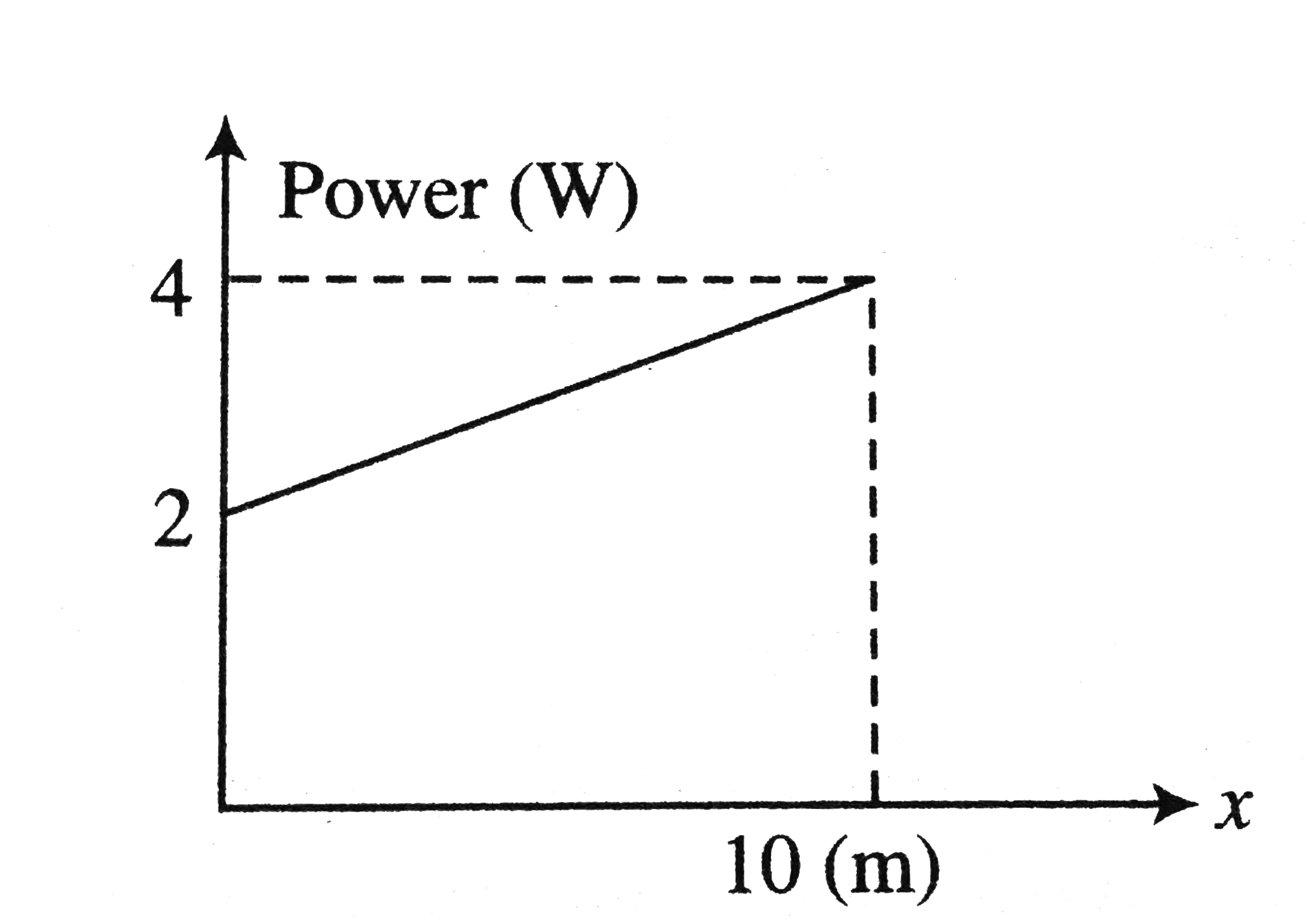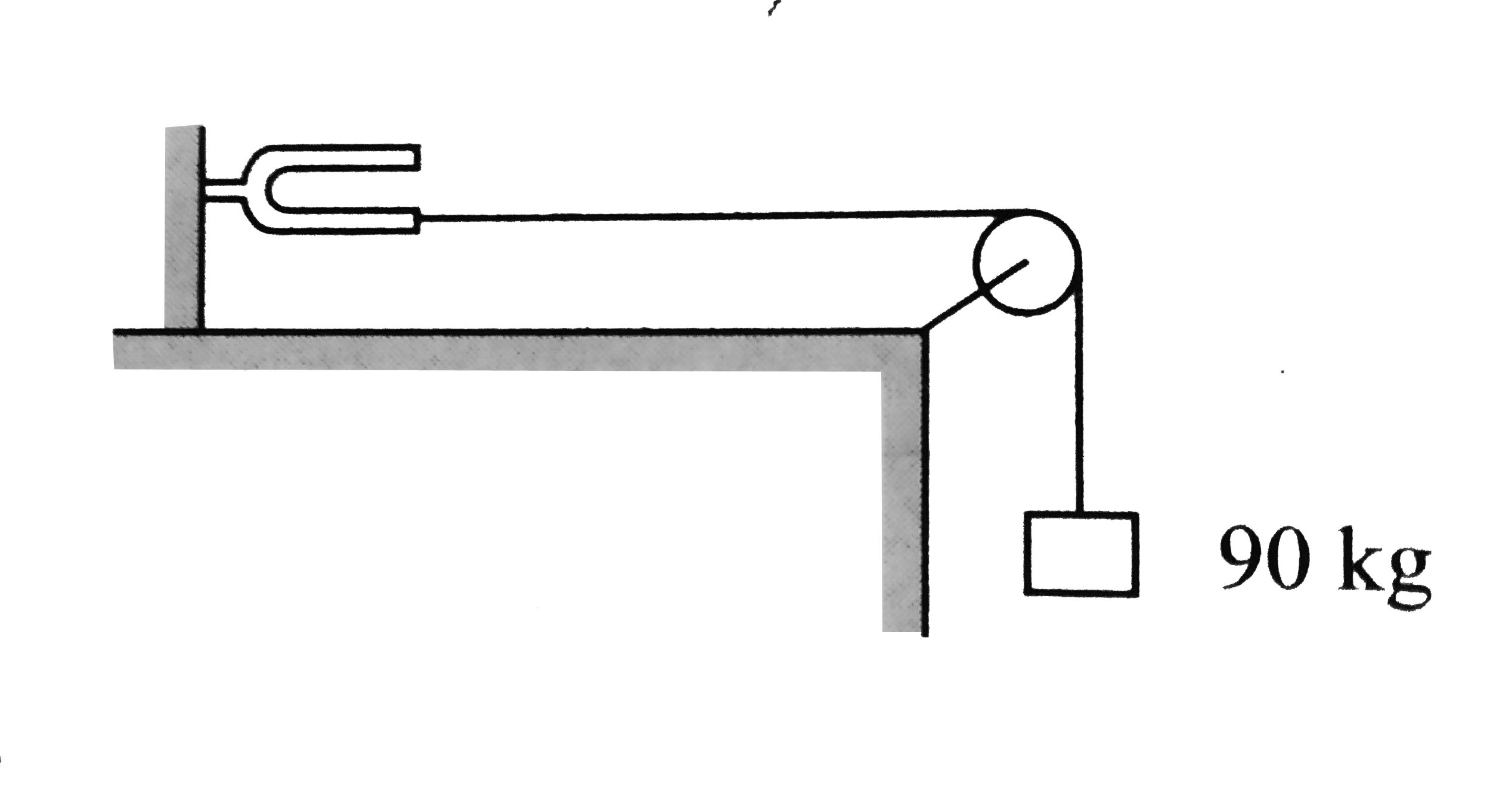In a standing wave experiment , a 1.2−kg horizontal rope is fixed in place at its two ends (x=0andx=2.0m) and made to oscillate up and down in the fundamental mode , at frequency of 5.0Hz. At t=0 , the point at x=1.0m has zero displacement and is moving upward in the positive direction of y−aξs with a transverse velocity 3.14m/s.
Tension in the rope is
60N
100N
120N
240N
The correct Answer is:D
To find the tension in the rope, we can follow these steps:
Step 1: Calculate the mass per unit length (μ) of the rope
The mass of the rope is given as 1.2kg and the length of the rope is 2.0m.
μ=masslength=1.2kg2.0m=0.6kg/m
Step 2: Determine the wavelength (λ) of the standing wave
In the fundamental mode of a standing wave, the length of the rope (L) is equal to half the wavelength (λ/2). Therefore, we can express the wavelength as follows:
L=λ2⟹λ=2L=2×2.0m=4.0m
Step 3: Calculate the wave velocity (v)
The wave velocity can be calculated using the formula:
v=f⋅λ
where f is the frequency. Given that the frequency f=5.0Hz:
v=5.0Hz×4.0m=20.0m/s
Step 4: Relate wave velocity to tension (T) and mass per unit length (μ)
The relationship between wave velocity, tension, and mass per unit length is given by:
v=√Tμ
We can rearrange this equation to solve for tension T:
T=μv2
Step 5: Substitute the values to find the tension
Now we can substitute the values of μ and v into the equation:
T=0.6kg/m⋅(20.0m/s)2
Calculating this gives:
T=0.6⋅400=240N
Final Answer
The tension in the rope is 240N.
---
The mass of the rope is given as 1.2kg and the length of the rope is 2.0m.
In the fundamental mode of a standing wave, the length of the rope (L) is equal to half the wavelength (λ/2). Therefore, we can express the wavelength as follows:
The wave velocity can be calculated using the formula:
The relationship between wave velocity, tension, and mass per unit length is given by:
Now we can substitute the values of μ and v into the equation:
The tension in the rope is 240N.
Topper's Solved these Questions
- SUPERPOSITION AND STANDING WAVESBOOK - CENGAGE PHYSICS ENGLISHCHAPTER - SUPERPOSITION AND STANDING WAVESEXERCISE - Integer
9 Videos
- SUPERPOSITION AND STANDING WAVESBOOK - CENGAGE PHYSICS ENGLISHCHAPTER - SUPERPOSITION AND STANDING WAVESEXERCISE - Single Correct Answer Type
56 Videos
- SUPERPOSITION AND STANDING WAVESBOOK - CENGAGE PHYSICS ENGLISHCHAPTER - SUPERPOSITION AND STANDING WAVESEXERCISE - Assertion - Reasoning
6 Videos
- SOUND WAVES AND DOPPLER EFFECTBOOK - CENGAGE PHYSICS ENGLISHCHAPTER - SOUND WAVES AND DOPPLER EFFECTEXERCISE - Integer
16 Videos
- THERMODYNAMICSBOOK - CENGAGE PHYSICS ENGLISHCHAPTER - THERMODYNAMICSEXERCISE - 24
1 Videos
Similar Questions
In a standing wave experiment , a 1.2−kg horizontal rope is fixed in place at its two ends (x=0andx=2.0m) and made to oscillate up and down in the fundamental mode , at frequency of 5.0Hz. At t=0 , the point at x=1.0m has zero displacement and is moving upward in the positive direction of y−aξs with a transverse velocity 3.14m/s.
Speed of the participating travelling wave on the rope is
View SolutionIn a standing wave experiment , a 1.2−kg horizontal rope is fixed in place at its two ends (x=0andx=2.0m) and made to oscillate up and down in the fundamental mode , at frequency of 5.0Hz. At t=0 , the point at x=1.0m has zero displacement and is moving upward in the positive direction of y−aξs with a transverse velocity 3.14m/s.
What is the correct expression of the standing wave equation ?
View SolutionA particle A of mass 10/7kg is moving in the positive direction of x-axis. At initial position x=0, its velocity is 1ms−1, then its velocity at x=10m is (use the graph given)

View SolutionA particle A of mass 10/7kg is moving in the positive direction of x−aξs. At initial position x=0, its velocity is 1ms−1, then its velocity at x=10m is (use the graph given)

View SolutionA wave travelling in positive X-direction with A=0.2m has a velocity of 360m/sec if λ=60m, then correct exression for the wave is
View SolutionA wave travelling in positive X-direction with A=0.2m has a velocity of 360m/sec if λ=60m, then correct exression for the wave is
View SolutionOne end of a long string of linear mass dnesity 8.0×10−3kgm−1 is connected to an electrically driven tuning fork of frequency 256 Hz. The other end passes over a pulley and is tied to a pan containing a mass of 90 kg. The pulley end absorbs all the incoming energy so that reflected waves at this end have negligible amplitude. At t=0 the left end (fork end) of the string x=0 has zero transverse displacement (y=0) and is moving along positive y-direction. The amplitude of the wave is 5.0 cm. Write down the transverse displacement y as function of x and t that describest the wave on the string.
View SolutionA 100 Hz sinusoidal wave is travelling in the positve x - direaction along a string with a linear mass density of 3.5×10−3kgm−1 and a tension of 35 N. At time t =0 ,the point x=0 has zero displacment and the slope of the string is π/20then select the wrong alternative.
View SolutionTransverse waves on a srting have speed 12.0m/s, amplitude 0.05m and wavelength 0.4m. The waves travel in the +x−direction and at t=0 the x=0 end of the string has zero displacement and is moving upwards.
(a) Write a wave function describing the wave.
(b) Find the transverse displacement of a point at x=0.25m at time t=0.15s.
( c ) How much time must elapse from the instant in part (b) until the point at x=0.25m has zero dispacement?
View SolutionOne end of a long string of linear mass density 10−2kgm−1 is connected to an electrically driven tuning fork of frequency 150 Hz. The other end passes over a pulley and is tied to a pan containig a mass of 90 kg. the pulley end absorbs all the incoming energy so that reflected waves from this end have neglidible amplitude , At t =0, the left end (fork end ) of the string is at x=0 has a transverse displacement of 2.5 cm and is moving along positive y-direction. the amplitude of the wave is 5 cm. write down the transverse displacement y (in cetimetres) as function of x(in metres) and t (in seconds ) that describes the wave on the string.

View Solution
